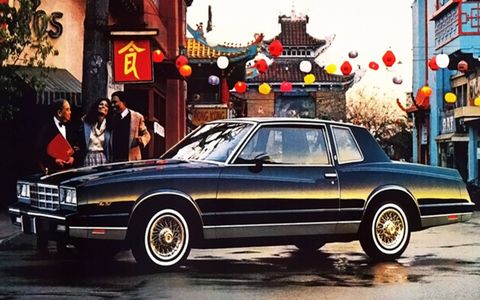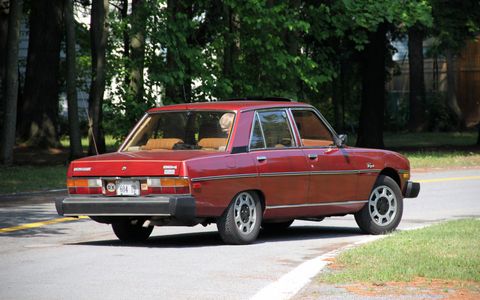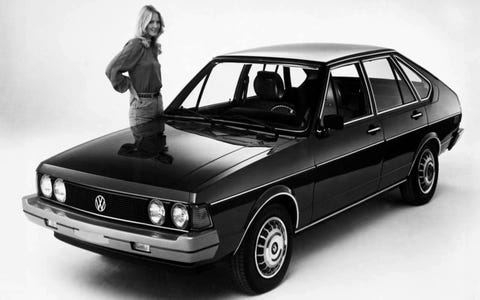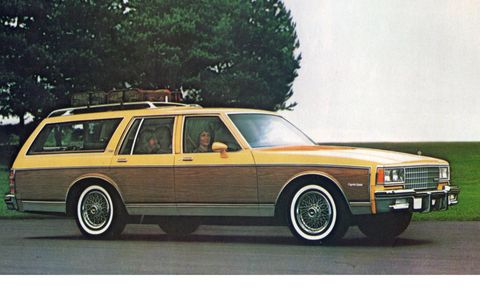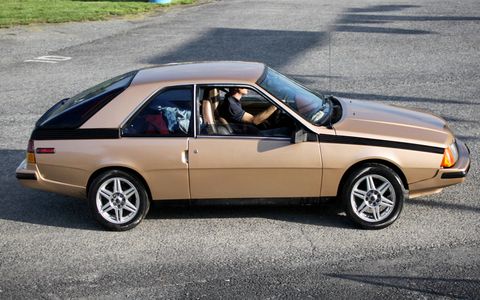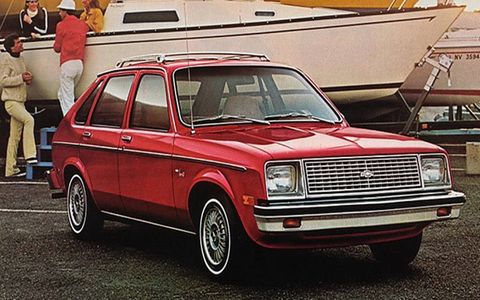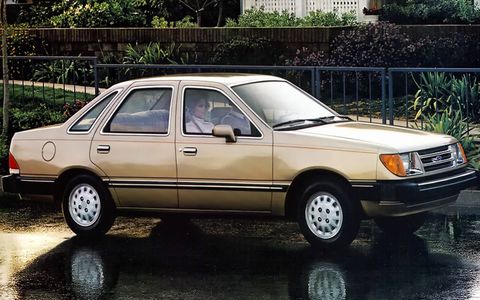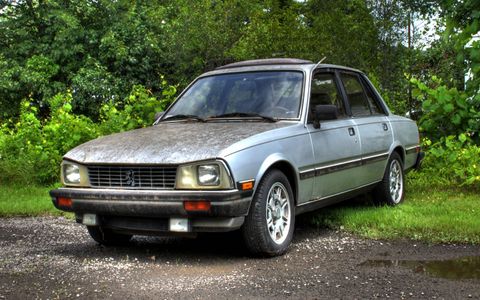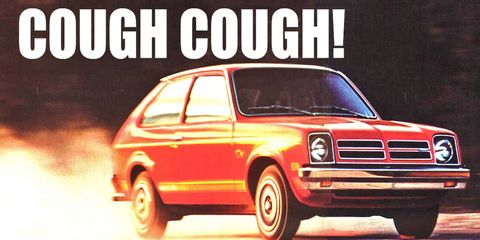
The oil crisis of the 1970s brought a crop of smaller cars, and for the first time in many years Detroit manufacturers were forced to learn how to make small diesel engines. But prices at the pump were one thing, and car development cycles were quite another. By the time diesels started appearing at dealerships in great numbers, the fuel-economy case for them had become slightly less pressing if not altogether moot.
Oldsmobile diesels may be the “best” remembered diesel experiment — they were experimental, all right — but there was a large variety of foreign and domestic cars sporting oil burners claiming various fantastical fuel-economy numbers.
Here’s a look back at some of the rare diesel cars from the soot-sodden late Malaise era.
Just as gas prices started heading down, Chevrolet stuffed an Oldsmobile diesel into the Monte Carlo for the 1982 model year. This was the same unit that debuted in the 1979 model-year GM cars—the 5.7-liter LF9 V8 engine with 120 hp on tap. The LF7 4.3-liter V8 diesel was on the menu as well, producing 90 hp. 1984 would be the last year of the diesels for the Monte Carlo, with their share of the Monte Carlo sales dipping into mere hundreds of units. We can just picture one of these at Barrett-Jackson’s Scottsdale sale in the year 2050, as the last remaining 1984 Monte Carlo diesel is started on the auction block to applause from the crowd.
Fuel economy: These could reportedly squeeze out 34 mpg on the highway, a miniscule improvement over the same engine in the Caprice sedan and wagon.
Are these valued higher than the gas model? These still have some time to age and appreciate before the 2050 Arizona in January auctions.
Can I find one today? Let us know if you do—we want to see it.
8-track tapes found in the glove compartment: Black Sabbath, America.
Styled by Pininfarina, the Peugeot 604 was the marque’s counterpoint to Citroën’s futuristic CX sedan, and in terms of design and philosophy the two couldn’t be more different. The U.S. version, however, was primarily known for two things: first, for having positively gigantic DOT rubber bumpers (great for sitting on), and second, for making good use of the somewhat-maligned PRV V6 engine. The three dozen prospective stateside buyers also received the option of a turbocharged diesel version, in the form of the 2,304cc Indenor inline-four badged as the 604 GTD.
Fuel economy: Real-world tests achieved a respectable 32.5 mpg.
Are these valued higher than the gas model? Most buyers tend to go for the meaty PRV V6, which is not without its share of problems.
Can I find one today? Among the 30 or so 604s believed to be in running condition in the U.S. today, there are only a handful of GTD models.
8-track tapes found in the glove compartment: ELO, Fleetwood Mac.
The first-generation Volkswagen Passat was sold as the Dasher in the U.S. Neither the gasoline nor the diesel model was particularly dashing but rather soberly designed in that familiar German way. The good news was that the 1.5-liter inline-four appeared on the market in 1979, so at least it wasn’t terribly late to the party. The bad news was that it produced all of 47 hp. That meant a 0-to-60-mph jog of just under 20 seconds. This fact failed to dent Dasher sales, which remained steady during this period.
Fuel economy: Low 40 mpg combined.
Are these valued higher than the gas model? There was a minty one on Bring a Trailer not that long ago, and the diesel VW crowd is very accepting of rare machines such as these.
Can I find one today? Just barely.
8-track tapes found in the glove compartment: Van Halen, The Clash.
It wasn’t just Oldsmobile and Cadillac that got diesel engines in the early 1980s (just as the business case for them was evaporating). GM spread the diesel love around, with woody-sided Chevrolet Caprice Classic wagon receiving the massive 5,737 cc diesel V8 engine for 1980 through 1985. Early units churned out 120 hp, while later versions produced all of 105 hp. Needless to say, this was not an energy-efficient engine by any stretch. Sales by the end of the production run had tapered off for the diesel model, as gas was back in vogue.
Ad copy boasted of a 462-mile range on a single tank, and up to 682 miles on the highway between fill-ups. “You can also drive that same New Chevrolet Diesel Wagon with the fuel economy usually associated with a compact car—an EPA estimated 21 mpg, 31 highway.” Chevrolet got the 682 mile figure by multiplying the EPA estimated figure by 22, the capacity of the gas tank. We can name a couple of issues with that approach, and all of them end with the car getting stranded on the side of the road.
Fuel economy: 21 mpg combined/31 mpg highway, per the old EPA estimate system.
Are these valued higher than the gas model? Nope. In fact, it’s tough to find one as the Olds diesels had plenty of issues. The more enterprising owners replaced the engines on theirs with later gasoline units, as these were still solid cars.
Can I find one today? It’s tough to find a clean gasoline example to begin with.
8-track tapes found in the glove compartment: Jackson Browne, The Cars.
The Oldsmobile Cutlass Salon Brougham, or “Bro” for short, was one of the first cars to receive the storied Olds diesel. Contrary to gearhead urban legend, the engine was not adapted from a gasoline version even if there are similarities in their construction and specs. Fraught with issues, the 4.3-liter LF7 V8 had trouble with water contamination because not enough thought was given to the fuel delivery system. The engines could also barely cope with the higher pressures inherent in diesel combustion. Head gasket failures at relatively low mileage intervals were common, but the only replacement parts were more of the same thing, so repairs only bought owners some time until a repeat of the same problems.
Fuel economy: When they ran, they could get combined mpg figures in the mid-20s.
Are these valued higher than the gas model? Definitely not.
Can I find one today? The gas models have proven to be pretty tough, and a number of them actually started out in life as diesels.
8-track tapes found in the glove compartment: Creedence Clearwater Revival, Deep Purple.
The Fuego found its way to our shores via AMC’s partnership with Renault, which among other things, resulted in Renaults being made in French car-friendly Kenosha, Wisconsin. But before Renault Alliances started rolling off the line in the Rust Belt, the company offered its existing wares to American consumers, with the sporty Fuego among them. In 1982, two years into production, Renault introduced a turbodiesel version of the modern-looking coupe. The Douvrin 2.1-liter turbocharged inline-four ended up being the fastest production diesel car in the world, with a version of this unit also being offered in the Winnebago LeSharo in the States. The turbodiesel produced all of 88 hp, but it was actually a fairly reliable unit.
Fuel economy: Real-world tests pegged combined fuel economy in the low 30s.
Are these valued higher than the gas model? Not really.
Can I find one today? The 2.2-liter gas versions in top spec are just about the only ones that have survived, but we have in fact seen a turbodiesel Fuego just in the last couple years.
8-track tapes found in the glove compartment: Joy Division, Kraftwerk.
The tiny Chevette also was late arriving to the diesel party, but it didn’t get one of the Oldsmobile units (even though we would have loved to see that thing in the engine bay). Instead, it was a 1.8-liter Isuzu unit producing 51 hp and 72 lb-ft of torque. The diesel was available all the way through the 1986 model year, by which time the engine and the car were hopelessly outdated. And few people needed or wanted diesel engines in their small family cars. Most surprising of all, the Isuzu engine was actually relatively reliable.
Fuel economy: A very impressive 40-mpg combined EPA rating, with 55 mpg on the highway. Real-world highway mpg figures in the high 50s have been reported.
Are these valued higher than the gas model? There aren’t that many Chevettes in relation to which the word “valued” could be used.
Can I find one today? These have had a lengthy production run, so it’s definitely possible. Just don’t expect it to have run anytime in the last two decades.
8-track tapes found in the glove compartment: Dire Straits, Eagles.
GM wasn’t the only domestic automaker dabbling in diesels in the late 1980s. Ford was interested in oil burners as well, but it wasn’t about to risk developing them by itself and spreading them out across several brands. So it went to Mazda for a 2.0-liter inline-four that produced 52 hp. That was a pretty low power figure even for a 2.0-liter unit without the help of a turbo—alarmingly low in fact—but it did help the Tempo achieve an alleged 56 mpg on the highway. Needless to say, these were not a popular option on the Tempo, as by 1984 the price of gas was largely a non-issue, and the 2.3-liter gasoline units could actually scoot the car around pretty well.
Fuel economy: EPA 41 combined/56 mpg highway.
Are these valued higher than the gas model? If only for the novelty value.
Can I find one today? As these diesel units were pretty well sorted, there are still some running around.
8-track tapes found in the glove compartment: The Allman Brothers, Neil Young.
The 505 range was already a popular sedan and wagon duo, at least in some parts of the country, and the range was also available with diesel engines for a time. While the first diesels were borrowed from the Peugeot 504, two newer turbodiesel engines were offered for the 1985 and 1986 model years: the 2,498cc XD3T inline-four with 94 hp on tap and the later XD3TE engine that also sported an intercooler, with 108 hp. Their arrival made their availability moot when it came to selling on fuel economy.
Fuel economy: 24 city/30 highway/26 mpg combined was the best these could muster with manual transmissions. The automatic-transmission versions paired with diesel engines did not yield a tremendous advantage in fuel economy over gasoline models.
Are these valued higher than the gas model? Only if they’re in stellar condition will the homebrew-diesel crowd pay a premium. We’ve seen it happen.
Can I find one today? There are a handful here and there, but it’s the PRV V6 models into which enthusiasts are investing their francs.
8-track tapes found in the glove compartment: KISS, Ramones.
The Volvo 240 had been out since 1976 and was already selling well in the U.S., with little complaint about fuel economy. But in 1979, Volvo introduced a 2.4-liter inline-six diesel engine sourced from Volkswagen, codenamed the D24. To get buyers interested, Volvo dressed up the GL model with standard features like a heated driver’s seat, 12-vent air conditioning, and a sunroof. The latter two options, you’ll notice, are to facilitate fresh air, and we think it’s no coincidence these two luxe options were tacked onto the diesel model.
Period ad copy was surprisingly sobering: “We can’t guarantee you’ll rack up a hundred thousand miles on your Volvo. But chances are you won’t end up having to trade it in just about the time you’re done paying for it, either.”
Fuel economy: 29 mpg city/37 mpg highway
Are these valued higher than the gas model? Only by the homebrew-diesel crowd, who might just get in a bidding war over a car they want that suddenly pops up on Craigslist.
Can I find one today? These pop up very infrequently—we’ve only seen a couple examples here and there.
8-track tapes found in the glove compartment: Queen, Pink Floyd.
Source: Read Full Article

